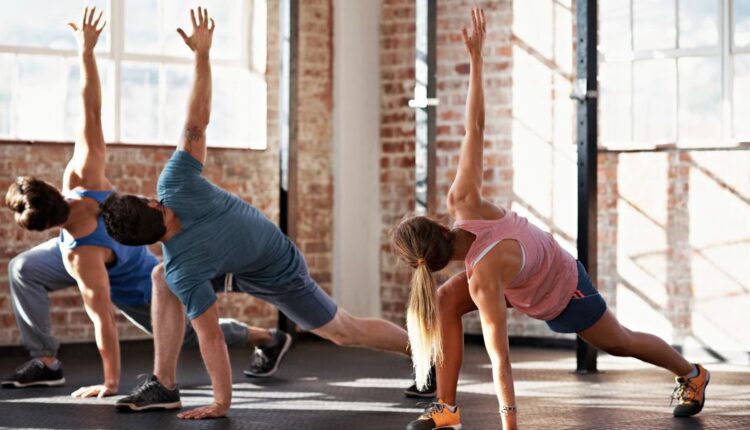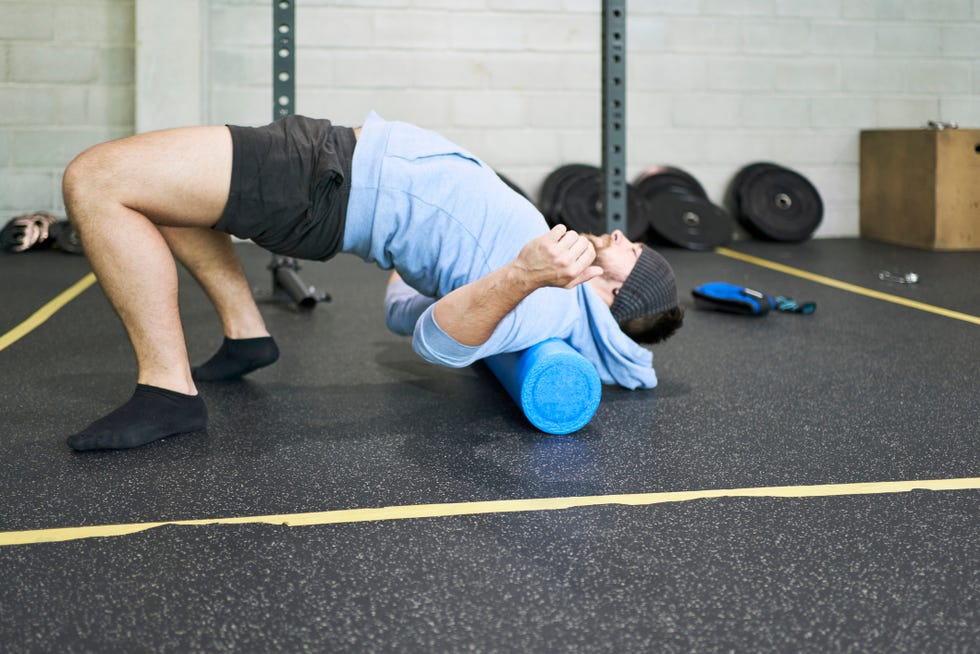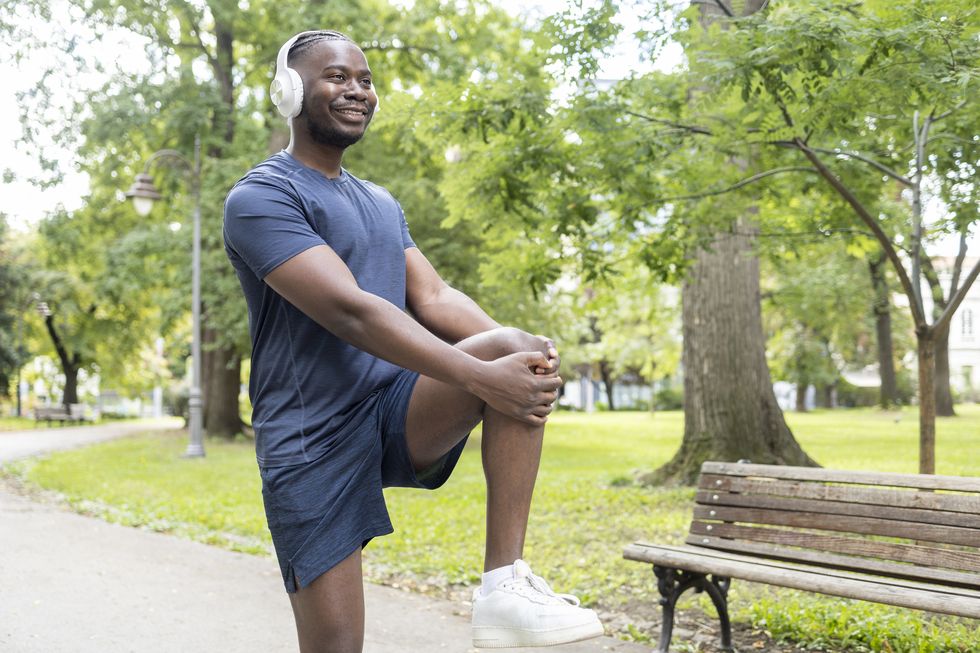WANT TO LOOK GOOD? Lift some weights and eat healthy. Want to feel good, too? Stretch.
“That’s what makes [stretching] vital,” says Mike Boyle, co-founder of Mike Boyle Strength and Conditioning in Massachusetts, and a former strength coach for pro and Olympic teams. “If you want to feel better as well as look better, then stretching has to be part of your program.”
The main question, then, becomes when? Since your gym class days, you’ve probably had teachers, coaches, and gym bros tell you to stretch (or not to) at different times—either before your workout, or as a cooldown once your lift, run, or ride is finished.
For Boyle and Men’s Health fitness director Ebenezer Samuel, C.S.C.S., the answer is to stretch before your workout. Doing so won’t just help you feel good—it can also help with performance, reduce pain and discomfort, and provide valuable bio-feedback that can make your session smarter and stronger.
Your stretching routine doesn’t have to eat into your training time, either. You can get these benefits in just a few minutes—and get some bonus recovery boosts by tacking on some extra stretching at the end of your workout, too. Here’s how to move well and feel better with a pre-workout stretch, and how to do it in five minutes with a four-move routine from Renato Sanchez, DPT, C.S.C.S., of Bespoke Treatments in San Diego.
How to Stretch Before Your Workouts
Forget what you learned in elementary school: A pre-workout stretch doesn’t mean reaching from your toes and holding that position. In fact, you shouldn’t reach and hold at all, Samuel says.
“You want to be warming up for your workout. You want to take your joints through a relatively large, controlled range of motion,” he says. “So you want to do dynamic stretches that get your heart rate up and move you through patterns in an active way.” At the end of these movements, like Spiderman lunges and thoracic rotations, you’ll reach ranges of motion that stretch you into and out of tougher ranges of motion as you’re moving.
Another stretching don’t, Boyle says, is diving straight into a stretch session once you’ve laced up your shoes. “It’s like if you’re trying to get Play-Doh back from when it’s hard. What do you do? You start to work it a little bit first,” he says. “After a couple of minutes, then you’re ready to stretch it.” To work the stiffened Play-Doh of his athletes’ muscles and joints, Boyle starts with foam rolling. This warms up the tissue and makes it more malleable so it can stretch.
Once you’ve started stretching, don’t over-stretch, Sanchez says. “Growing up, coaches would tell me to get ‘ballistic’ with my stretches, bouncing around at the end of the range I could really reach,” he recalls. But going into ranges beyond your limits can result in strains and injuries, especially when you’re still warming up.
Just like when you’re picking up a barbell, drop your ego when you start stretching: Your range of motion in each position is your personal range of motion, not a predetermined mark like touching your toes no matter what. Move until you feel a good stretch in the position, Sanchez says, but not so far that you start to feel pain.
3 Performance Benefits of Stretching Before Workouts
Stretching Lengthens Muscles
In order to move through exercises properly, your muscles and joints need to have a certain amount of length, and a certain amount of tension, Boyle says. Without enough length, your body will find a way to compensate to do the move with another muscle or joint—even if it hurts.
If you’re doing a walking knee hug during a warmup, he says, but you haven’t stretched your hip, your back will compensate: Your low back will wrench to help get your knee up, and your chest will come towards your knee, using your upper back to move into the desired position. Stretching the hip before this type of movement “reminds” your muscles of the length they’ll need for those movement patterns, Boyle says. So when you do the hip hug, your hip will move. The same goes for bigger, heavier moves that have greater chances of creating pain.
“If your hip flexors are tight and your pelvis is anteriorly tilted, and then you go in and start squatting, you have a greater chance of experiencing low back pain,” he says. “If you spend some time stretching before that and restore the length that you need with your hip flexors, abdominals, and hamstrings, more than likely what you do after that is going to work better.”
This doesn’t just reduce the potential for pain, Sanchez says, but also can make your squats better. When you’re stretched out and warmed up, you may actually be able to lift more.
Stretching Provides Instant Feedback That Can Improve Your Workout
When you stretch before you lift or run, you do more than just warm up, Samuel says. You get information about how you’re feeling and moving that day.
“That’s the underrated part of stretching: It creates awareness,” he says. “When I stretch, I might notice that my chest is feeling not great or extra tight today. Then I have that knowledge when I sit down to bench press.”
When people say to “listen to your body,” this is what they mean: The kind of feedback that stretching provides, Samuel says, can tell you when it’s time to back off on an exercise for the day, or when you’re feeling so great that you can gun for a personal record.
Stretching Can Help Prevent Long-Term Injury or Dysfunction
“When we start thinking about things like chronic low back pain or any ‘itis’es, those are going to be a result of muscles changing length over time,” Boyle says. “Look at a grandmother or grandfather: Where their head or chest is. They’re hunched forward. You’ve got muscles on one side that have gotten long, and muscles on the other side that have gotten short.”
Stretching fights against this, he says—but you won’t safeguard your posture in a single session or a day. Just as these changes happen over time in tiny increments, stretching helps keep things at their optimal lengths by stretching them again and again over time.
“It’s a little bit of care that puts everything back where it’s supposed to be, so you don’t look at it when you’re 60 or 70 and say, ‘oh, look at my posture,’” he says. Stretching consistently may help you avoid these painful problems down the line.
Should I Stretch After My Workout, Too?
To Sanchez, the question of whether to stretch before or after a workout begs another question: “Why not both?”
Stretching after a workout, he says, can help fend off soreness, start the recovery process, and just leave you feeling good. “In your workout, you push your body to the limit. But you want to take care of your body as well, and not go 100 miles per hour all the time. The stretching cooldown helps you do that,” he says. “Let’s breathe a lot, and down-regulate the parasympathetic nervous system.”
In a post-workout stretch, Sanchez says, you can perform the same types of movements you did before your workout, but linger a little longer. When you reach the end range of a lunging stretch or twist, stay there long enough for a few deep, diaphragmatic breaths, then move to the next position.
“This breathing triggers the phrenic nerve, and that travels up to the brain. It’s releasing everything: All these different hormones then down-regulate your body,” he says. “Then when you walk out, you’re like, ‘wow, I feel like a new person. I feel so calm.’ And all the stress you had at work or at home is gone.”
The 5-Minute, 4-Movement Pre-Workout Stretch Routine
Lots of guys get in the gym and skip their warmup to slide right under a barbell—missing all the performance benefits a pre-sweat stretch can bring. That’s in part, Sanchez thinks, because they think they’ve got to stretch for 10 or 20 minutes.
“Even just five minutes is enough to warm the body up and get the body going with some compound movement stretching,” he says. To get the most value from those minutes, Sanchez likes to get his hips, back, shoulders, and sides stretched in just a few moves—getting a little stretch for each during each maneuver.
He also doesn’t spend much time on each move. Each rep of your warm up stretch session, inhale while you’re moving, then hold the end of each position for a single exhale. That one cycle of breathing counts as one rep. Sanchez says to do each of these four moves for 6 to 8 reps on each side.
If you’ve got time for a cooldown after your workout, you can use these same moves. Just do each for a little longer: Do two breath cycles at the end range instead of one.
World’s Greatest Stretch
- Get in a high plank position, with your hands directly below your shoulders, and your body forming a straight line from head to heels.
- Step your right foot up close to your shoulder so that your foot is flat on the ground.
- Drop your left elbow towards the ground, feeling a stretch on the back of your thigh. Exhale.
- Straighten your elbow. Keep your left hand planted firmly on the ground. Lift your right hand off the ground and twist your torso so that your right hand goes towards the ceiling and your torso and arms form a capital “T” shape. Hold this for an exhale, then twist back down.
- Return to the pushup position and do the stretch on the other side. Repeat on each side 6 to 8 times.
Adductor Rock
- Kneel on the ground with your knees slightly wider than hip-width, your toes tucked under.
- Keeping your left knee where it is, straighten your right leg out to the side and place your right foot flat on the ground.
- Maintaining a flat back, inhale and lean forward at the waist and put your hands on the ground. Pull your hips back to feel a stretch in your upper back and shoulders. Hold for an exhale, then rise back up and repeat this.
- Inhale again, this time bending forward to place your hands on the ground and then threading your right arm under your left shoulder, bringing the right shoulder towards the ground. Exhale.
- Untwist your left arm and bring it up overhead so that your torso forms a “T” shape. Exhale here.
- Return your hand to the ground, then rise back up
- Repeat this sequence 6 to 8 times on this side, then switch your legs and do it all again.
Hand-Supported Hip Switch with Reach-Through
- Sit on your hips with your hands behind you for support, and your knees bent and heels on the floor in front of you. Your back should be flat, but at a slight angle back so you can be up on your hip bones.
- Rotate your thighs to the right like windshield wipers, pivoting your feet as you twist. Your right knee should go towards the floor, and your left knee should go towards your right heel.
- When your knees are rotated all the way to the right, lift your left hand off the ground and rotate your torso to thread your left arm under your right arm pit. Keep reaching through until the outside of your left shoulder reaches near the ground.
- Untwist your torso and put your left hand back behind you.
- Untwist your knees back to the starting position.
- Repeat the whole maneuver to the other side, windshield wiping your knees to the left this time, and threading you right arm under your left shoulder.
- Repeat for 6 to 8 reps.
Hand-Supported Shin Box with Overhead Reach
- Sit on your hips with your hands behind you for support, and your knees bent and heels on the floor in front of you. Your back should be flat, but at a slight angle back so you can be up on your hip bones.
- Rotate your thighs to the right like windshield wipers, pivoting your feet as you twist. Your right knee should go towards the floor, and your left knee should go towards your right heel.
- When your knees are rotated all the way to the right, lift your left hand off the ground and use your right hand to press up onto the outside of your shins. Squeeze your butt to extend your hips. Reach your left hand up and over your head to feel a stretch in the left side of your body.
- Bring your butt back to the floor and return your left hand behind you.
- Untwist your knees back to start, and repeat to the other side, this time reaching with your right hand to stretch the right side of your body.

Greg Presto is a fitness and sports reporter and videographer in Washington, DC.









Comments are closed.